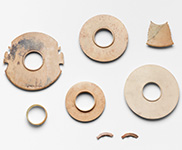C. T. Loo & Company
Business
1914-1948
Constituent Alternate Name(s)
C. T. Loo & Cie
Relations
Business Client: Zhang Naiji
Business Employee: Frank Caro, Lindsay Hughes Cooper, Berthe Oliver, Marion H. Weildon, Yusen Shen, Zhang Naiji
Business Owner: C. T. Loo
Place of activity: Paris, France; New York, New York, United States; Shanghai, China; Beijing, China;
C. T. Loo remains one of the most prominent--and controversial--figures in the world of Chinese art. Born in the village of Lujiadou, west of Shanghai, his real name was Lu Huanwen. He was raised by relatives after his father, an opium addict, and his mother, a field laborer, died when he was a child. Years later while serving as a cook for Zhang Jinjiang, a diplomat and wealthy merchant, Loo arrived in Paris in 1902. Deciding to rewrite the story of his birth and early years in China, the young man changed his name to Lu Qinzhai. In the West, some people called him Cheng-tsai Loo, and others referred to him as Loo Ch'ing-tsai. Eventually his name was shortened to C. T. Loo.
In France, Loo quickly adopted Western ways and rose from servant to shop assistant in Zhang's Chinese import business dealing in raw silk, tea, carpets, porcelain, lacquer, and antiques. His innate business acumen meshed with the growing Western interest in Chinese artifacts and China's tumultuous break with its past. In 1908 Loo established his own small gallery, Lai-Yuan and Company, in Paris from which he sold inventory acquired from other European dealers. Three years later, in 1911, in an effort to obtain high-quality objects directly from China, he opened offices in Beijing and Shanghai. When the Qing dynasty fell that same year, millennia of imperial rule came to an end--and thousands of objects and sculptures from temples, mausoleums, and imperial and private collections flooded the art market. Loo acquired and sold items--at greatly inflated prices and sometimes under unscrupulous circumstances or with questionable provenance--to private collectors, such as Charles Lang Freer, and to museums in the West, including the Metropolitan Museum of Art in New York, the Museum of Fine Arts in Boston, the British Museum in London, and the University of Pennsylvania Museum in Philadelphia.
Loo's prominence as a Chinese art dealer continued throughout the 1920s and 1930s. He opened the "Pagoda," a five-story red structure at 48 rue de Courcelles in Paris in 1928 and filled it with his vast collection of Chinese stone sculptures, murals, and bronzes. During these decades the Chinese art trade flourished as new museums in the United States were founded and interest in collecting Chinese antiquities grew. His business began to decline in the 1940s when a new generation of museum curators and art dealers emerged, the United States entered World War II, and civil war broke out in China.
Loo remained active as an art dealer until 1950, when he retired at the age of seventy and liquidated his collection. Shortly before that, the communists under Mao Zedong had gained control of China, and Loo's supply lines were cut. The new communist government condemned Loo's Chinese business associates as counter-revolutionaries and accused him of bribery, fraud, and the theft of state goods. The US trade embargo against China, which was enacted in 1951 and lasted for twenty-seven years, essentially ended Loo's long career. Whether Loo should be vilified for taking art treasures out of China or praised for saving a cultural heritage and enlightening Western collectors about Chinese art still remains a point of contention.
Literature
Yiyou Wang, "The Loouvre from China: A Critical Study of C. T. Loo and the Framing of Chinese Art in the United States, 1915--1950," PhD diss., Ohio University, 2007.
Daisy Yiyou Wang, "C. T. Loo and the Chinese Art Collection at the Freer, 1915--1951," Arts of Asia 41, no. 5 (2011), pp. 104--16.
Eve M. Kahn, "A Chinese Dealer, Trafficker in Mystery," New York Times (September 6, 2012); see http://www.nytimes.com/2012/09/07/arts/design/notes-from-the-dealer-c-t-loo-and-pens-of-a-certain-age.html?_r=0
Graldine Lenain, Monsieur Loo, le roman d'un marchand d'art asiatique (Arles, 2013).
David Pilling, "CT Loo: Champion of Chinese art . . . or villain?" Financial Times (April 25, 2014); see http://www.ft.com/cms/s/2/cd747768-cb46-11e3-ba95-00144feabdc0.html#slide0
Peryl Tse, "C. T. Loo: Highs and Lows of a Great Art Dealer," Asia Society Hong Kong (May 26, 2014; includes link to a video of lecture given by Graldine Lenain); see http://asiasociety.org/hong-kong/ct-loo-highs-and-lows-great-art-dealer
Kate Whitehead, "Who Art You, Mr. Loo?" South China Post Magazine (November 9, 2014); see http://www.scmp.com/magazines/post-magazine/article/1632508/who-are-you-mr-loo
The Pagoda Paris, see http://www.pagodaparis.com/home.html

